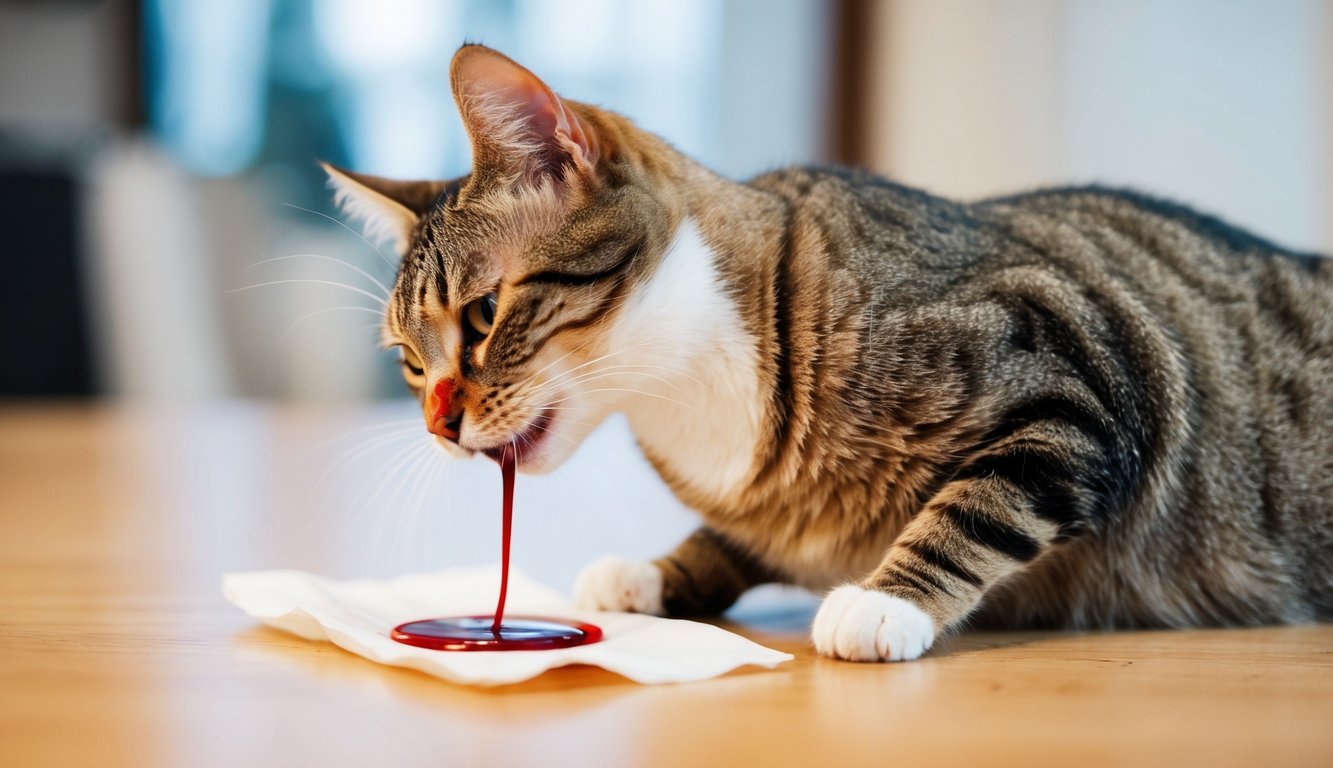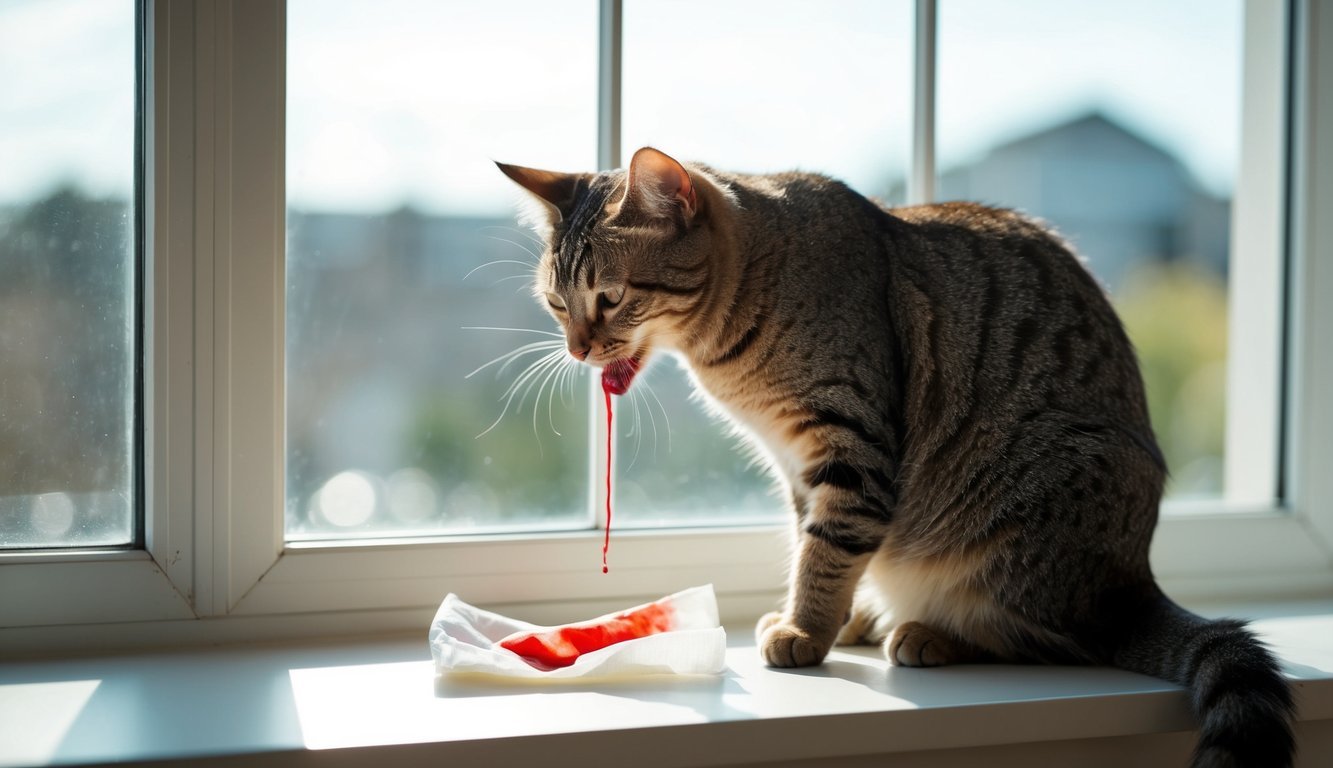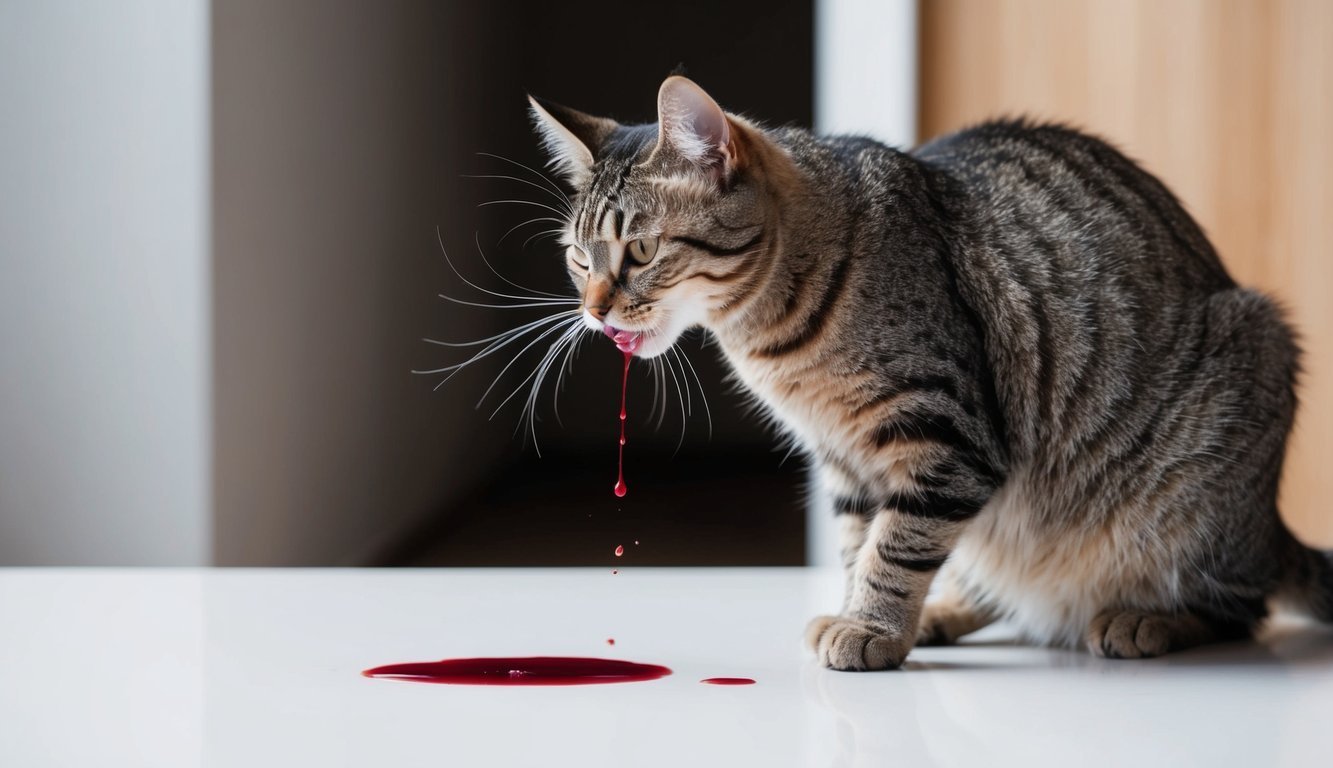Is your cat sneezing blood? Don’t panic, but take it seriously.
Cats can sneeze blood for many reasons.
Some are minor, while others need quick vet care.
If your cat sneezes blood, call your vet right away. They’ll help figure out what’s wrong and how to treat it.
Common causes include infections, allergies, and objects stuck in the nose.
Sometimes it can be a sign of more serious issues like tumors or blood problems.
While waiting to see the vet, keep your cat calm and comfortable.
Watch for other symptoms like trouble breathing or not eating.
Write down when the sneezing started and any other changes you’ve noticed.
This info will help your vet find out what’s going on with your furry friend.
Understanding Epistaxis in Cats
Epistaxis, or nosebleeds, in cats can be scary for pet owners.
It happens when blood vessels in the nose break and leak.
This can lead to blood coming from your cat’s nostrils or sneezing blood.
Common Causes of Nosebleeds
Several things can make your cat’s nose bleed.
Injuries are a common cause.
If your cat bumps their nose or scratches it, it might bleed.
Some cats get nosebleeds from infections.
These can be bacterial or viral.
Foreign objects stuck in the nose can also cause bleeding.
Sometimes, your cat might inhale a small object like a blade of grass.
This can irritate the nose and lead to bleeding.
High blood pressure is another possible cause.
If your cat has this condition, it can make blood vessels more likely to break.
Symptoms to Watch For
Besides seeing blood from your cat’s nose, there are other signs to look out for.
Your cat might sneeze more often than usual.
These sneezes might have blood in them.
You might notice your cat pawing at their face or rubbing their nose.
This can be a sign that something is bothering them.
Some cats might have trouble breathing or make snoring sounds.
Watch for changes in behavior too.
Your cat might eat less or seem less active.
If the bleeding is bad, your cat could become weak or tired.
When to Seek Veterinary Care
If you see your cat sneezing blood, it’s best to call your vet.
Even a small amount of blood can be a sign of a bigger problem.
Don’t wait to see if it gets better on its own.
Seek immediate care if the bleeding doesn’t stop after a few minutes.
Also, get help right away if your cat has trouble breathing.
If your cat seems very weak or won’t eat, these are also reasons to see a vet quickly.
Your vet can find out what’s causing the nosebleed.
They might need to do tests or look inside your cat’s nose.
Getting quick treatment can help your cat feel better faster.
Diagnosis and Diagnostic Tests
Finding out why your cat is sneezing blood requires careful examination and testing.
Your vet will use various methods to figure out the cause and plan treatment.
Veterinarian Examination and History
When you bring your cat in, the vet will ask about your pet’s symptoms and health background.
They’ll want to know when the bloody sneezing started and if you’ve noticed any other issues.
The vet will then check your cat from nose to tail.
They’ll look closely at the nose, mouth, and face for signs of injury or infection.
They might also feel for lumps or swelling.
Your vet will listen to your cat’s breathing and heart.
They’ll check for fever and look at the eyes for signs of illness.
Blood Tests and Imaging
Blood tests can show if your cat has an infection or other health problems.
The vet may take a small blood sample to run these tests.
X-rays help vets see inside your cat’s nose and chest.
These pictures can show tumors, foreign objects, or other issues that might cause bloody sneezing.
Sometimes, vets use CT scans for a more detailed look.
These scans give a 3D view of your cat’s head and can spot problems X-rays might miss.
Advanced Diagnostic Procedures
If basic tests don’t find the cause, your vet might suggest more advanced options.
Endoscopy lets vets look inside your cat’s nose with a tiny camera.
This can help find polyps, tumors, or foreign objects.
Vets might take small samples of tissue or fluids from your cat’s nose.
They’ll look at these under a microscope to check for cancer or specific infections.
In some cases, your cat might need to see a specialist.
They can do more complex tests to find out what’s causing the problem.
Treatment Options

When your cat is sneezing blood, quick action is key.
The right treatment depends on what’s causing the problem.
Here are some ways to help your furry friend feel better.
Immediate Care and Stabilization
If you see your cat sneezing blood, stay calm.
Keep them quiet and still to stop more bleeding.
Use a cold pack on their nose for a few minutes.
This can help slow the blood flow.
Don’t let your cat scratch their nose.
Call your vet right away.
They might ask you to bring your cat in.
The vet will check your cat’s breathing and overall health.
They may give fluids if needed.
In some cases, they might need to stop the bleeding with special tools.
Long-Term Management
For ongoing care, your vet might prescribe antibiotics.
These help if there’s an infection causing the problem.
You may need to give your cat pills or liquid medicine.
If allergies are the issue, your vet might suggest antihistamines or nasal sprays.
These can reduce swelling in your cat’s nose.
For blood clotting problems, your cat might need special medicine.
This helps their blood clot better.
You’ll need to watch your cat closely and avoid things that could make them bleed.
Surgical Interventions
Sometimes, surgery is needed to fix the problem.
If your cat has a foreign object stuck in their nose, the vet might remove it surgically.
This is usually a quick procedure.
For nasal tumors, surgery can be more complex.
The vet might need to remove part of the tumor.
They might also use other treatments like radiation.
If your cat keeps getting nosebleeds, they might need surgery to fix blood vessels in their nose.
This can help stop the bleeding for good.
Prevention and Well-Being

Taking care of your cat’s health can help prevent issues like sneezing blood.
Regular vet visits and staying up-to-date on shots are key ways to keep your furry friend healthy.
Routine Check-Ups
Bring your cat to the vet at least once a year.
These check-ups can catch problems early.
Your vet will look at your cat’s nose, mouth, and teeth.
They’ll check for signs of infection or other issues.
Ask about testing for common cat illnesses.
Your vet might suggest blood work or other tests.
This can help spot health problems before they get worse.
Don’t skip dental care.
Brushing your cat’s teeth or using special treats can help prevent gum disease.
Bad teeth can lead to infections that cause sneezing blood.
Vaccination and Disease Prevention
Keep your cat’s shots up to date.
Vaccines protect against many illnesses that can cause sneezing and nose problems.
Get your cat vaccinated for feline calicivirus.
This virus can cause severe cold-like symptoms, including sneezing blood.
Ask about shots for other respiratory infections.
These can help prevent many causes of sneezing and nasal issues in cats.
Keep your home clean to reduce allergens.
Dust and vacuum regularly.
This can help if your cat has allergies that irritate their nose.


